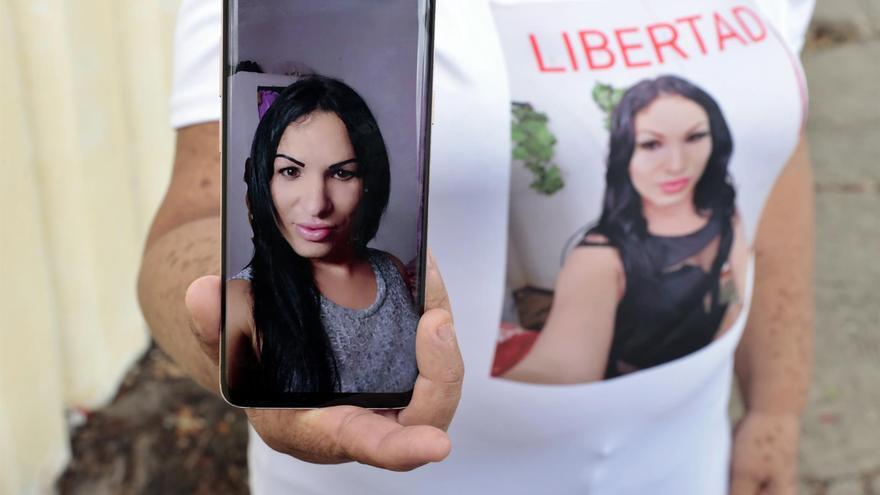
![]() EFE (via 14ymedio), Juan Carlos Espinosa, Havana, 20 July 2022 — The face of the Cuban Ana María suddenly changes from total seriousness to a smile from ear to ear when the cell phone rings and she sees that Brenda is on the other end.
EFE (via 14ymedio), Juan Carlos Espinosa, Havana, 20 July 2022 — The face of the Cuban Ana María suddenly changes from total seriousness to a smile from ear to ear when the cell phone rings and she sees that Brenda is on the other end.
It is her trans daughter – an option that Cuban legislation does not contemplate – who is imprisoned in the men’s section of a prison for participating in the anti-government protests on July 11, 2021.
“Hello, my life!” shouts the mother at a bus stop in Havana, dressed in a white T-shirt with the image of the 28-year-old girl emblazoned with the word “freedom.”
Brenda Díaz is serving a 14-year sentence in the prison of the Güines municipality (Mayabeque). It is a special penitentiary center — with a section for men and another for women — for people with the HIV virus, like her.
Although in prison she has never lacked her retrovirals –essential in the treatment of HIV-positive people. Ana María must bring her medications for other illnesses she suffers from, such as chronic gastritis and kidney stones, and which are not available in prison, according to what her mother said in an interview with Efe.
“Before I used to see her every 15 days, but now the (prison) directive has changed and I won’t be able to visit her until the end of the month,” Ana María complains bitterly. The last time she saw her was on July 5.
A municipal court sentenced Brenda last March for the crimes of public disorder and sabotage, according to her sentence, to which EFE had access.
Díaz was arrested along with her 16-year-old brother, Luis Manuel, who tried to prevent the arrest. The minor was released 17 days later, with a fine of 1,000 Cuban pesos.
The sentence claims that Brenda threw stones at one of the controversial foreign currency stores in her Güira de Melena municipality, entered the establishment with a group of protesters and stole a “wall fan, a pressure cooker and a box of jams.”
According to the prosecution’s indictment, Brenda – who was tried as a man and under her legal name, Freddy Luis – had the flowered dress she was wearing at the time of participating in the march confiscated.
Once in prison, she was shaved and placed in the men’s section. Her hair, which she cared for with devotion, vanished in a matter of minutes and that caused her to fall into a strong state of depression, according to her mother.
Ana María reviews the details of the case with a stoicism that is interrupted when she begins to relate that her daughter has already suffered a sexual assault in prison.
Her voice cracks with a tone that mixes anger with sadness: “Sometimes I can’t even talk about it… she’s my life. Because of her illnesses, because of everything. I still can’t get over her being locked up.”
Her daughter’s sentence is not final and on June 17 the appeals trial was held, with which Ana María hopes that the sentence can be reduced or that Brenda can serve her sentence in freedom. So far, the family has not received any notice from the court.
Until June 22, the Cuban Public Ministry had reported firm sentences against 488 11J protesters, with maximum sentences of 25 years for crimes such as sedition, public disorder, attack and contempt.
In the accusation against Brenda, the Prosecutor’s Office collects data that, for the journalist and trans activist Mel Herrera, is “re-victimizing” and “stigmatizing.” For example, in the brief it is highlighted that Díaz wore a dress, that she is HIV-positive and her gender identity is confused with a “sexual orientation.”
“The clothing had nothing to do with what was being judged. It was not a weapon, it was not conclusive evidence. That dress, by pointing it out, is simply revealing a prejudice because the State is wanting to say that that person is in disguise,” complains Herrera in a telephone interview.
In addition, in a paragraph the court highlights that before the 11J protests she was rejected by her neighbors for “engaging in disturbances of the public order,” without specifying what is meant by that.
Herrera recalls that in Cuba it is possible to change the legal name of a trans person on their identity card and also the photo, but not the gender registered at birth.
This legal vacuum allows other arrested trans people like Brenda to end up in prisons that do not correspond to their gender identity. The 2019 Cuban Constitution recognizes the principle of “non-discrimination based on gender orientation and identity.”
In addition, the country will submit the Family Code to a referendum in September, a legislative package that seeks to legalize same-sex marriage, among other issues. However, this will not include changes in legislation to facilitate gender change.
The case of Brenda “shows that although there is political will and an openness from the government, it is very difficult for this to be reflected in practice,” concludes Herrera.
____________
COLLABORATE WITH OUR WORK: The 14ymedio team is committed to practicing serious journalism that reflects Cuba’s reality in all its depth. Thank you for joining us on this long journey. We invite you to continue supporting us by becoming a member of 14ymedio now. Together we can continue transforming journalism in Cuba.
